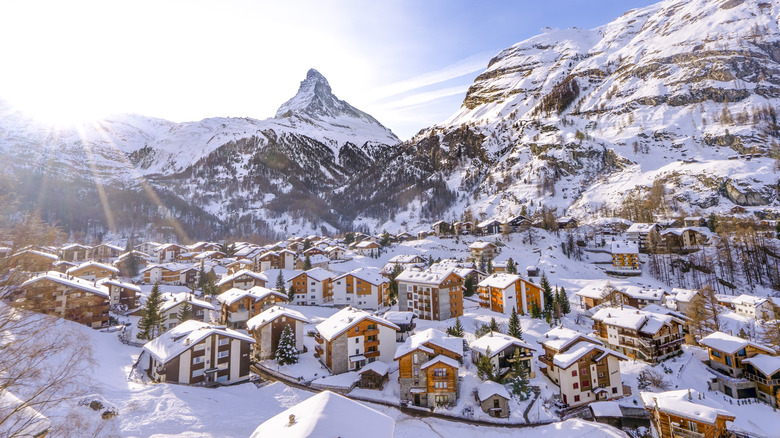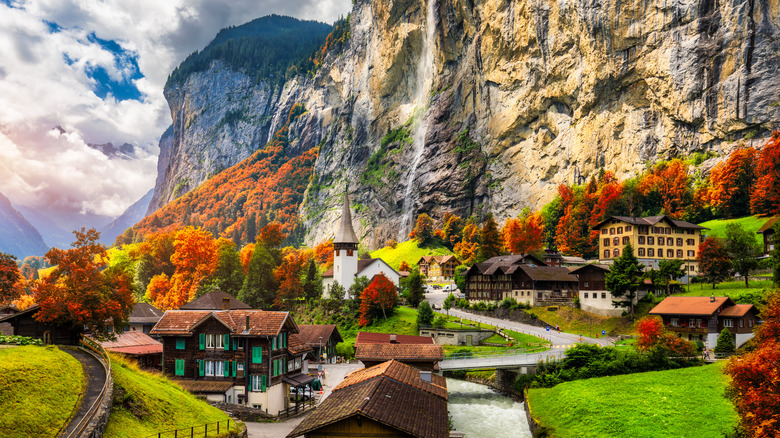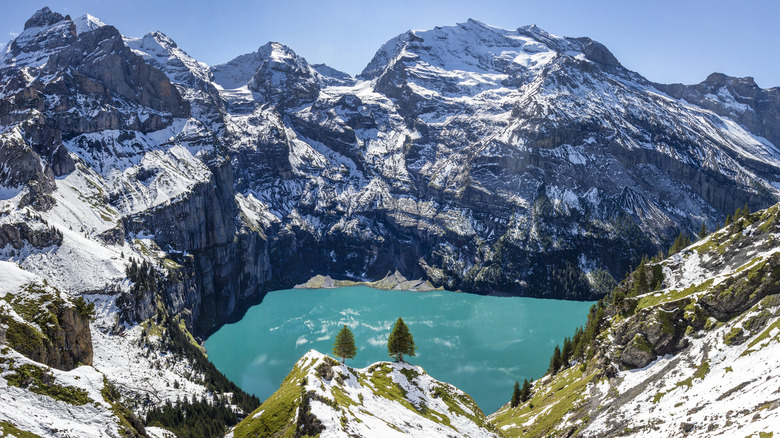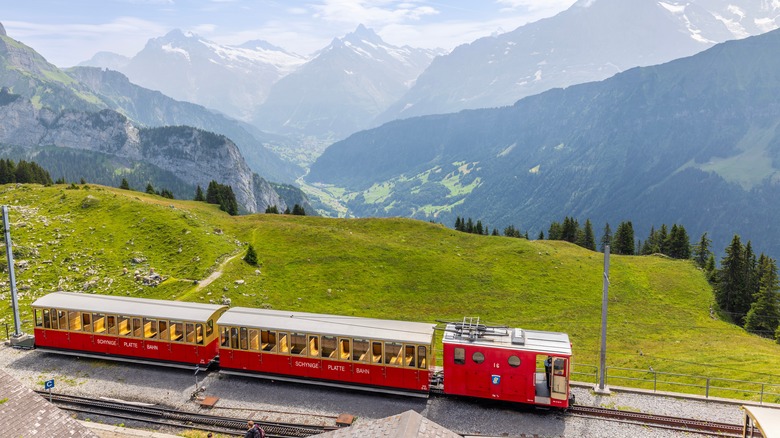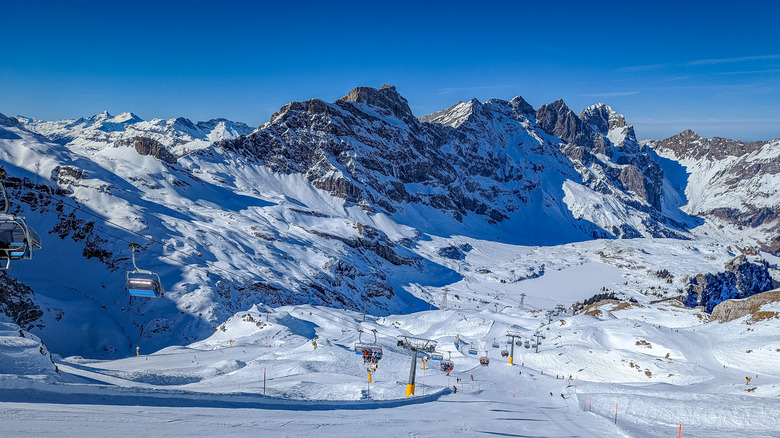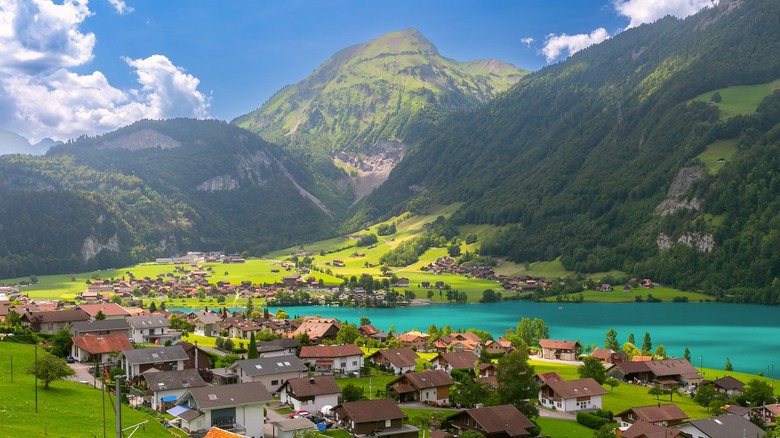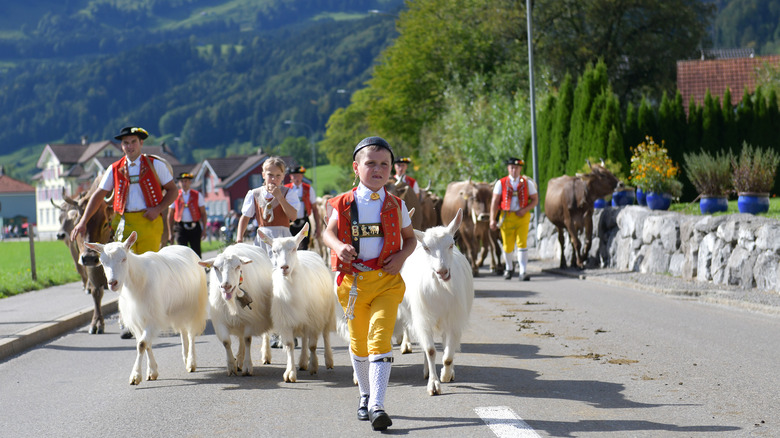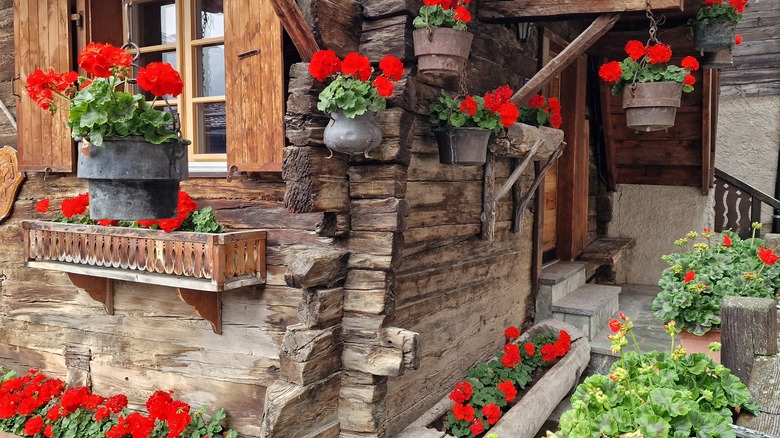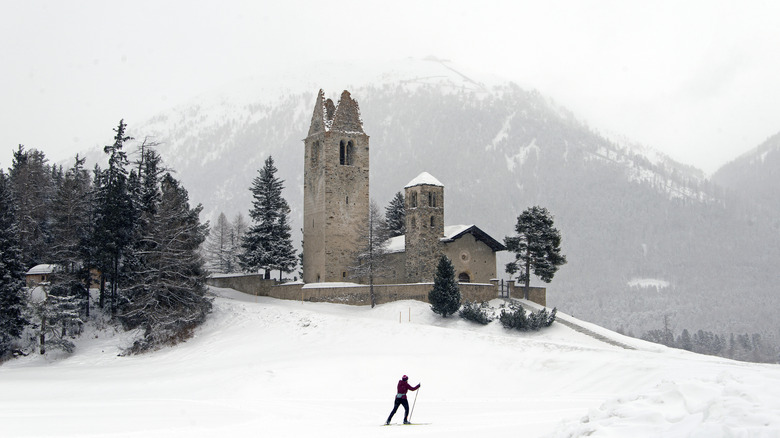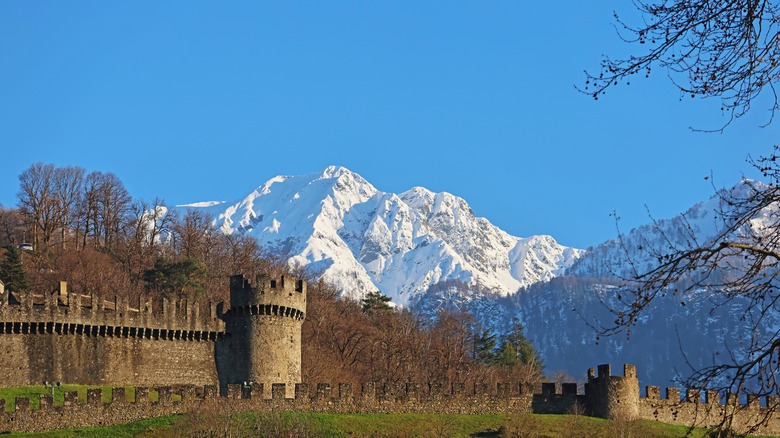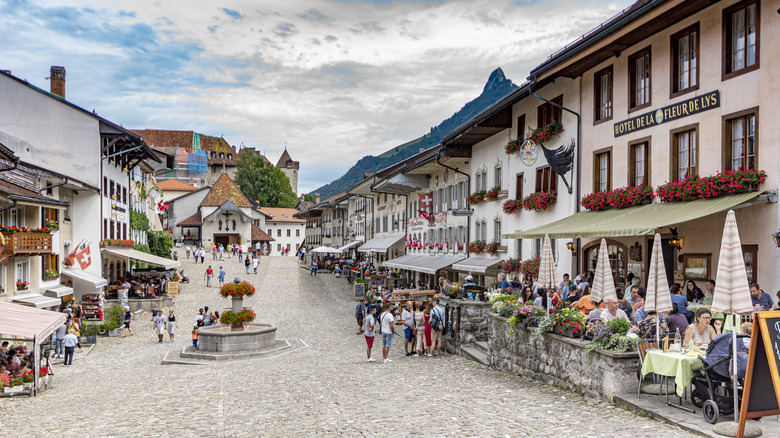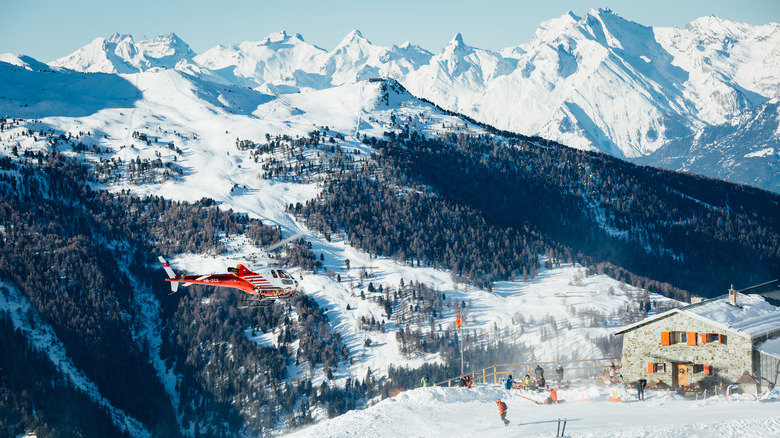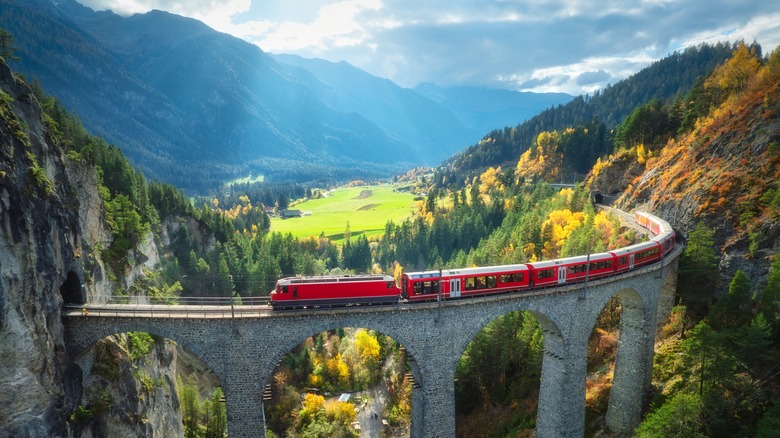The Most Budget-Friendly Towns For A Stay In Switzerland, According To Travel Guides And Tourism Data
Switzerland's beauty is legendary. Think snow-draped peaks mirrored in turquoise lakes, trains that glide past waterfalls, and villages so pretty they feel hand-painted. As real as the postcard is, unfortunately, so is the price tag. But not every corner of Switzerland is designed for premium wallets.
Beyond the heavyweights, such as Switzerland's prettiest and most iconic destinations of Zermatt, Bern, St. Moritz, Geneva, and Lucerne, are smaller towns and Alpine hamlets where the charm runs high and the prices dip noticeably lower. "Affordable" here, of course, is relative. While there are budget-friendly ways to enjoy European cities and towns, we are still in Switzerland — which isn't shoestring territory. There are still little corners in this country where rooms — particularly in youth hostels — ski-lift passes, campsites, regional transport cards with discounts, and even supermarket meals come in well below the prices in the country's marquee destinations. There are ample hikes through valleys and up mountains that don't charge an entry fee, as well as lakes, streams and rivers that cost nothing to swim in. There are also free or modestly priced cultural events in towns and villages.
Switzerland's relatively budget-friendly corners are where charm, scenery and culture meet less daunting costs. From Appenzell's pastoral heart and Bellinzona's medieval castles to Grimentz's flower-draped chalets and the "star resort" of St-Luc, you don't have to spend like royalty to experience authentic Switzerland. You will, of course, still need to budget carefully.
Lauterbrunnen
If Lauterbrunnen feels like the kind of place that got pulled straight out of a storybook, that's because it almost is. Or perhaps it's the other way round. This little Swiss village that sits in a valley in the Jungfrau region, right outside the pricier Interlaken, is said to be J.R.R. Tolkein's inspiration behind Rivendell in the "Lord of the Rings" novels. With 72 waterfalls cascading into a lush valley, Lauterbrunnen looks like a painting from another world. In fact, that's where this place also gets its name from: "Lauter brunnen" literally means "loud springs." The town offers a host of campsite options wherein one can opt for basic tent pitches at about $40 USD per night that can go up to about $76 for more premium camping options. Dorm beds in hostels, in an eight-bed dorm, are available at a starting price of about $45 USD per night.
The free valley trails keep overall expenses low. In addition, the Bernese Overland Pass lets you travel the entire region across all modes of transport, including trains, buses, boats and many smaller mountain railway services, allowing you to make the most of discounts of up to 50% on several routes, depending on when you go. One of the most common mistakes tourists should avoid in Switzerland is failing to utilize the transit system there.
Kandersteg
Had there been a hidden gem award in Switzerland, Kandersteg would be a finalist. Sitting high in the Alps, at 3,900 feet above sea level in the Bernese Oberland region, this charming village doesn't scream for attention the way Zermatt and Interlaken do, and that's exactly it's good for your soul and for your wallet. The star attraction here is Lake Oeschinensee, a turquoise mountain gem that can be reached by a breathtaking gondola ride or by a slightly breathless free hiking trail. For families with toddlers, there is also a footpath that's stroller-friendly. Food and lodging here run more moderately by Swiss standards. Simple guesthouses, B&Bs, lodges and hostels fall in the range of under $50 per night with hostel beds starting at $27 per night.
Kandersteg is also home to the 100-year-old Kandersteg International Scout Centre, the only recognized World Scout Centre, which is a big draw for travelers and backpackers. Here you can rent beds in chalets for $22 per night and a campsite for just $12 per person for one night. Many accommodations also include the Kandersteg guest card which grants free bus rides and discounts on cable cars, keeping transport costs in check. What further adds to its appeal, is that it's just about an hour by train from Bern, the Swiss capital, which makes it easily accessible for day trips while dodging capital city price-points.
Wilderswil
Less than 10 minutes by train and bus from Interlaken, this village that sits between Lake Thun and Lake Brienz, a top draw in the Bern region, is the gateway to the Jungfrau region in Southwestern Switzerland. The region boasts a multitude of lakes but around 20 lakes in particular stand out for their stunning Alpine settings and accessibility from the Wilderswil zone. Day trip options abound across the Jungfrau area, dominated by the Jungfrau peak sitting at a dizzying height of 4,158 meters (over 13,600 feet) — the country's crowning glory, both literally and figuratively. Wilderswil is also the starting point of the Schynige Platte Railway, a heritage cogwheel train that's been running since 1893. It takes you up to Schynige Platte (6,500-plus feet) with sweeping views of the Eiger, Mönch, and Jungfrau. And this ride, which otherwise costs about $81 USD for a full fare ticket, or free for Bernese Overland Pass holders.
Accommodation in Wilderswil is refreshingly reasonable by Swiss standards, with single rooms in downtown hotels starting at about $94 USD per night. For a taste of adventure, one can also opt for the campsites at base of Jungfrau for about $61 USD per night. Think "Interlaken-lite" — same access, same region, without the premium.
Engelberg
The name means "Mountain of Angels" and perhaps that's not an exaggeration. This enchanting village sits at an impressive height of over 3,400 feet with the highest point, Mt. Titlis, perched at about 10,000 feet. Engelberg is known as much as a monastery town as it is for its legendary snow-covered slopes making it a prime skiing destination at surprisingly grounded prices, especially when compared to flashier alternatives like Zermatt. Here the daily cross-country skiing pass is priced as low as about $13 USD. The Benedictine Monastery in Engelberg dates back to the 12th century, whose grounds and church and can be accessed for free by visitors — a rarity in Switzerland. The snow-covered Mt. Titlis, is the village's main draw for its unmatched ski terrain. Lift passes here are also markedly cheaper than the elite resorts.
For lodging, dorm beds in hostels start at about $63 USD per night. Those looking for accommodation in hotels and B&Bs, can find rates starting at about $90 USD per night. Add in the Tell-Pass that covers trains, boats and mountain railways across Central Switzerland, and Engelberg becomes an affordable launchpad for exploring a wider region, that includes the expensive city of Lucerne, only an hour away by train.
Obwalden
This is the wider canton where Engelberg is located and provides more number of options for affordable stays — in fact, it's known to be one of the cheapest cantons in Switzerland with lower than average living costs. While tourism in the region has expanded in recent years, parts of Obwalden are still not swarming in numbers as compared to other Swiss top draws like Zurich and Lucerne. According to the Obwalden Tourism Annual Report, the region recorded 235,093 overnight hotel stays in the Sarneraa Valley, which is part of Obwalden. Compare this to over 344,000 in Zurich and a staggering 1,412,735 in Lucerne in 2024. And in all three instances, as with most regions in Switzerland, tourists from the United States ranked among the leading visiting groups.
With its reliable network of transportation, this region provides easy connectivity to these bustling tourist hubs. The region in Central Switzerland draws its appeal mainly for the lakeside charms of Lake Sarnen and Lake Lungern, aside from stunning views of Mount Pilatus. There are also plenty of free hiking trails suitable for all levels of expertise.
The canton provides a range of choices in affordable lodging options in its villages and towns, starting from about $89 per night. Families looking for longer stays can opt for three-room apartments starting at about $1,704 for a month. So whether it's thrill-seekers or pasture-grazers, this canton promises a classic Swiss experience without breaking the bank.
Appenzell
Unlike the Alpine valleys of Lauterbrunnen or the Jungfrau-adjacent villages, Appenzell offers a gentler, rolling-hills version of Switzerland. Here there are no steep, snow-clad slopes or glacial valleys in the immediate vicinity, but a patchwork of green pastures, painted houses and centuries old tradition. There are no astronomical rates here either, as this canton in the northeastern part of the country is touted as the cheapest place to live in Switzerland. Appenzell has a rural heart through and through, where artisanal cheese, folk music, seasonal cattle processions, handicrafts weave themselves together in a uniquely immersive experience.
The village is laden with affordable accommodation choices for tourists, where double rooms in hotels start at $80 per night. Furthermore, the Appenzeller Holiday Card lets you explore a range of benefits for a minimum stay of three nights. In terms of free hiking trails, one is spoiled for choice — be it gentle valley trails or challenging routes up the Alpstein Mountains. Also, among Appenzell's many offbeat offerings is a rare barefoot hiking trail, a playful experience for children and adults, that doesn't cost a penny. Furthermore, hiking in this region can be a uniquely cultural experience too, wherein you can witness the ancient tradition of transhumance, or seasonal rotational grazing of livestock, often to the background score of traditional yodeling and cowbells.
Grimentz
If Appenzell is all rolling meadows and pastoral traditions, Grimentz could well be its Alpine opposite. This medieval hamlet tucked deep into Val d'Anniviers — an Alpine valley south of the Rhone — is perched at a lofty height of 5,095 feet and is affectionately called the "geranium village." Its timbered chalets, richly darkened by centuries of sun, with color splashes of geraniums spilling from its intricately carved balconies, likely earned the place this nomenclature. In Grimentz, while simply wandering through its cobbled streets lined with these medieval chalets is a charming pursuit in itself, the surrounding Val d'Anniviers trails offer panoramic views at no cost. Hikes around the Moiry Glacier are particular spectacular, and parking in the area doesn't cost a dime.
Grimentz also shines as a budget-friendly skiing destination. This region is otherwise known for its sky-high ski-resort pricing in the nearby hubs of Zermatt and Verbier, but Grimentz provides a welcome respite from the same. Unlike other skiing resorts that have witnessed considerable overdevelopment due to inflated tourism, this skiing resort village has managed to remain a quieter, under-populated secret. Rooms in hotels and hostels in downtown and in the nearby areas surrounding the village start at $60 per night while skiing lodges can be found at under $150 per night. Both season tickets and daily average ski pass are markedly cheaper than Verbier and Zermatt, with a difference ranging from anywhere between $6 to $674 for daily and season passes, respectively.
Zuoz
This hidden gem sitting in the upper Engadin offers a calmer, less tourist-heavy alternative to St. Moritz, just a 20-minute ride by train or bus. Winding through the town are narrow streets lined with centuries-old Patrician houses, including the well-preserved Chesa Planta. Featuring classic bay windows and elaborately sgraffitoed exteriors, these houses have earned Zuoz a reputation as the most beautiful village in the Engadin region of Switzerland. The town center offers a quiet grandeur with its ancient churches, piazzas, and fountains, making every turn a postcard worthy view. Hikers can set off straight from town into the Engadin's meadows, alpine streams, and trails without spending a dime.
Winter is when Zuoz quietly shines. It shares the same vast Engadin-St. Moritz winter sports region as St. Mortiz with a sprawling snow network of 218 miles of ski runs at kinder price points. An adult lift-ticket day pass here is about $52 while St. Moritz can climb to just over double of that, at about $110, going by the newly announced rates for the upcoming skiing season. Cross-country skiing, snowshoeing and beginner-friendly local slopes make it perfect for budget-conscious travelers who don't want to skimp on scenery. Zuoz is also family-friendly and is recognized as such by the Swiss Tourism Federation. Safety and accessibility for children are top priorities here, since beginners can practice in an easier, supervised area. Accommodation is also gentler on the wallet, with hotels, and holiday apartments starting at around $120 per night for a double bedroom. Campsites on the outskirts also offer space for between four to eight people for $120 per night.
Bellinzona
Bellinzona stands apart from the rest of Switzerland for its medieval fortifications and Mediterranean flair. Here, the view isn't just scenery; it's practically time travel. Tucked in the Italian-speaking Swiss canton of Ticino, Switzerland's sunniest region, the town is famous for its trio of UNESCO World Heritage castles — Castelgrande, Montebello and Sasso Corbaro — each offering sweeping valley views. While Castelgrande allows free entry to the castle grounds, Montebello extends this perk during winter months only. However, the Fortrezza Pass, at about $36, offers a smart, cost-effective way to explore all three castles along with their museums and exhibitions with one ticket.
The old town, with its narrow alleys, pastel-hued houses, piazzas and restored palazzi with Renaissance art, feels almost Tuscan, but at far better prices than Northern Italy's tourist hubs. Market days here are a delight, with local cheese, breads and fantastic homegrown wines that don't break the bank. The region is abundant in free hiking trails, whether it's climbing slopes to the castles or heading out to savor panoramic Ticino Valley views.
Bellinzona also makes for an affordable base to explore Ticino's lakes, Lugano and Locarno, without footing their hefty accommodation bills. Hotel rooms can be found at a starting rate of $85 per night while entire apartments are available for just under $200 — ideal for larger groups or families. Further lightening costs is the Ticino Ticket that provides free public transport and several discounts at partner attractions. The ticket is offered at over 500 partner accommodations, that include hotels, youth hostels and campsites across the canton of Ticino.
Gruyères
Another Swiss town oozing with medieval charm is in the Fribourg canton. Gruyères could well be the Switzerland one imagines from postcards — a hilltop medieval town crowned by a 13th century castle, cobbled streets winding past chalets and flower-decked balconies leaning into the sun. A little like Grimentz and equally budget-friendly but Gruyères has its uniqueness contained in medieval castles and ancient cheese cellars rather than glaciers and ski runs. It is compact, walkable, and almost museum-like in its preservation — which means most sights and experiences can be savored for free or at low rates. Home to the famous Gruyerè cheese, the town invites visitors behind the scenes at La Maison du Gruyerè, where you can watch wheels being crafted by hand, employing century-old methods and secret recipes for a modest fee of about $10 for adults.
Budget travelers will also appreciate that Gruyères can be a cheap base compared to bigger hubs like Montreaux and Gstaad, less than two hours away by train. While local inns, guesthouses and hotels often undercut flashy ski resort prices with starting rates under $150 per night, even fondue experiences here are more affordable at rates under $25 per person. Furthermore, the regional day pass bundles in serious value: unlimited public transport plus admission to Gruyères Castle, the Maison du Gruyère dairy show, and even the Maison Cailler chocolate factory.
Saint-Luc
High up in the mountains, Saint-Luc (or St-Luc) is where rugged alpine scenery collides with a touch of cosmic curiosity. Perched at over 5,400 feet, this mountain village offers unobstructed views over the Val d'Anniviers, including the famous Matterhorn, which Rick Steves calls the Stonehenge of Europe, at just shy of 15,000 feet. While the moniker "star resort" might conjure images of luxury price tags, it actually comes from the François-Xavier Bagnoud Astronomical Observatory that St-Luc is home to, and the famous Planets Trail, a free outdoor simulation of the solar system, where hikers journey from the sun to Pluto, in scale, against the backdrop of glittering alpine peaks.
For skiers, St-Luc is part of the Val d'Anniviers network, which makes it a quieter, more affordable alternative to crowded resorts like Crans-Montana or Zermatt. Ski passes here are significantly cheaper starting at around $67 USD for a day pass, and lift queues are also shorter and more manageable. Accommodation too leans on the reasonable side, with family-run hostels, and guesthouses starting at around $90 per night per person. In summer, the hiking trails open up to wildflower meadows, glacial lakes, and ridge-top views that would cost a fortune in more commercialized Swiss corners demanding hefty entry fees, but here, they're free for anyone with sturdy boots and time to wander.
Methodology
Information for each town was carefully compiled from a combination of official tourism websites, accommodation booking platforms, cost-of-living reports, and reputable travel guides and blogs, ensuring that all data on lodging, transportation, and local attractions are both accurate and current. Each destination was selected based on four key criteria: affordability relative to Swiss standards, scenic or cultural significance, ease of access for travelers relying on public transport or regional transit, and the nearest premium hub they can be a potential alternative to. Insights are supplemented by verified statistics, regional transport schedules, published accommodation rates, and insights drawn from established travel blogs and guide platforms, creating a comprehensive picture of what each town offers. The goal was to provide readers with practical guidance for planning a budget-conscious Swiss trip, while also conveying the distinctive character, charm, and experiential value of each destination, so that affordability does not come at the expense of memorable travel experiences. Prices are given in USD based on exchange rates at the time of writing.
